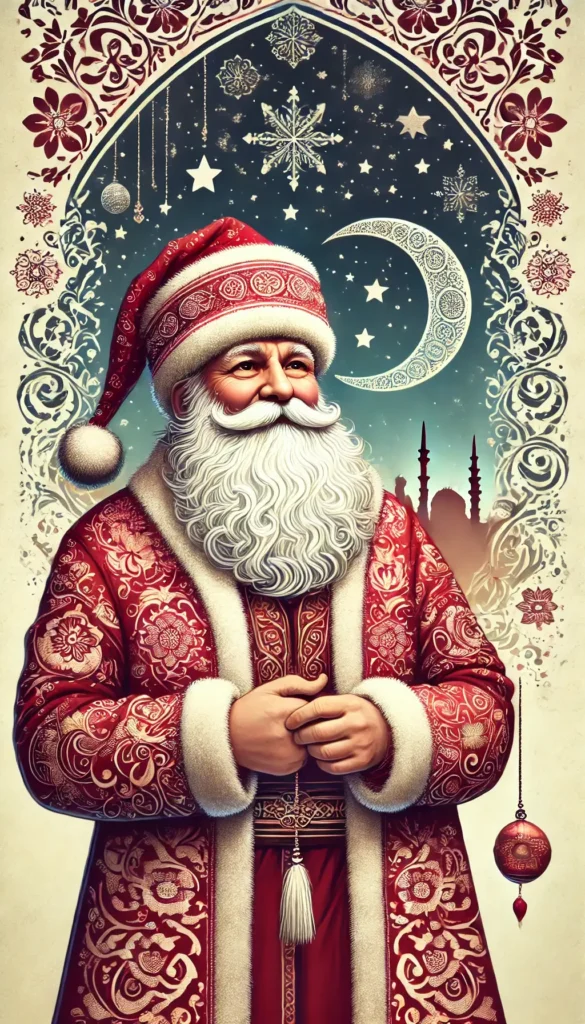Is Santa Claus Turkish? The Surprising Origins of St. Nicholas
When we think of Santa Claus, images of a jolly man in a red suit delivering presents on Christmas Eve might come to mind. But the true origins of Santa Claus are much older and far from the North Pole. In fact, Santa Claus traces his roots to a 3rd-century saint who lived in what is now Turkey. Yes, you read that right—Santa Claus might just be Turkish!
In this blog post, we’ll explore the fascinating history of St. Nicholas, the man behind the legend of Santa Claus, and how his story transformed over time into the beloved figure we know today.
The Real Santa Claus: St. Nicholas of Myra
The figure who would eventually become known as Santa Claus was actually a Christian bishop named Nicholas, born around 270 AD in Patara, a city in ancient Lycia, located in present-day Turkey. Raised in a wealthy family, Nicholas became known for his deep devotion to Christianity and his generosity toward the poor. After his parents died, he inherited a significant fortune, which he used to help those in need.
He later became the Bishop of Myra (modern-day Demre, Turkey), where his acts of kindness and miraculous deeds earned him widespread admiration. Nicholas was particularly famous for his secret gift-giving, and many legends about him spread across the region. He was deeply concerned with the welfare of children, the poor, and sailors.
The Legend of St. Nicholas
The most famous legend associated with St. Nicholas involves him secretly helping three impoverished sisters by providing dowries so they could marry. According to the story, the family was so poor that they could not afford to marry off the daughters, and without a dowry, they would be sold into slavery. Learning of their plight, Nicholas secretly tossed bags of gold through the family’s window at night, saving the girls from a grim future. This act of generosity laid the foundation for the story of Santa Claus as a gift-giver.
In another tale, St. Nicholas calmed a fierce storm at sea, saving sailors who were praying for his help. Because of this, he became the patron saint of sailors and travelers, adding to his reputation as a protector.

From St. Nicholas to Santa Claus
Over the centuries, St. Nicholas became one of the most venerated saints in the Christian world. His feast day, celebrated on December 6, was a time for gift-giving and charity, especially toward children. As his popularity spread across Europe, his image and story evolved, eventually merging with local traditions and customs.
In Dutch tradition, St. Nicholas became Sinterklaas, a figure who delivered gifts to children. When Dutch settlers brought their customs to America, Sinterklaas transformed into the figure we know today as Santa Claus.
By the 19th century, writers like Clement Clarke Moore and illustrators such as Thomas Nast reshaped the image of Santa into the merry, red-suited figure we recognize today. However, the roots of the legend lie firmly in the history of St. Nicholas of Myra, the Turkish bishop whose kindness inspired countless stories.
Why is St. Nicholas Important in Turkey?
While the modern image of Santa Claus is often associated with Western traditions, the origins of St. Nicholas are deeply rooted in Turkey’s history. His birthplace, Patara, and his long service as the bishop of Myra make him an important figure in Turkish heritage.
Today, visitors can explore Demre, where the Church of St. Nicholas still stands. The church is a major pilgrimage site for Christians and history enthusiasts alike, and it offers a glimpse into the life of the saint who inspired the global legend of Santa Claus. The St. Nicholas Museum in Demre also houses relics and exhibits related to his life, giving visitors a chance to learn more about the true history behind the jolly old man.
St. Nicholas’ Legacy Around the World
The transformation of St. Nicholas into Santa Claus is a testament to how legends and cultural symbols evolve over time. From his humble beginnings in ancient Turkey to his status as a global symbol of generosity, the story of St. Nicholas has transcended borders, religions, and traditions.
In addition to his influence in Turkey, St. Nicholas is also revered in countries like Italy, where his relics were moved to the city of Bari in the 11th century, and Russia, where he is considered a key figure in the Eastern Orthodox Church.
Every year, thousands of pilgrims visit both Demre and Bari to pay homage to this beloved saint. For Christians, St. Nicholas represents selflessness and compassion, while for children and families worldwide, he symbolizes the joy of giving and receiving during the holiday season.
Is Santa Claus Turkish?
While the modern-day Santa Claus is a product of many cultures and traditions, his roots can be traced back to the ancient region of Lycia, in what is now Turkey. St. Nicholas of Myra, with his acts of charity and gift-giving, laid the foundation for one of the world’s most recognizable and beloved figures.
So, the next time you see a Santa Claus decoration or hear a story about him delivering presents, remember that the real Santa Claus might just be from Turkey!
Visiting the ancient city of Myra and exploring the St. Nicholas Church in Demre offers a unique opportunity to connect with the historical roots of Santa Claus, making it a worthwhile destination for history buffs, religious pilgrims, and curious travelers alike.